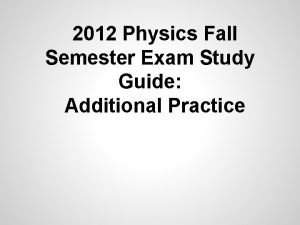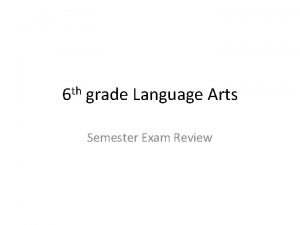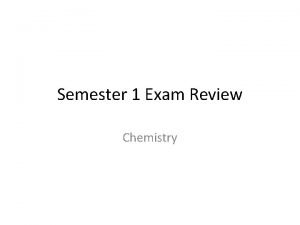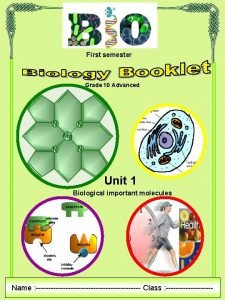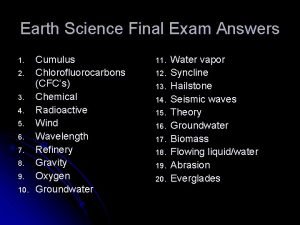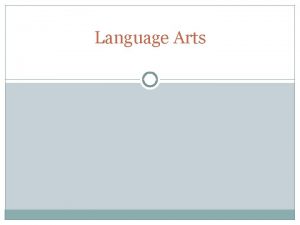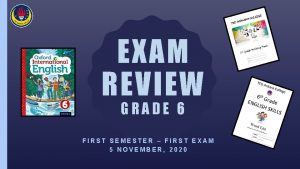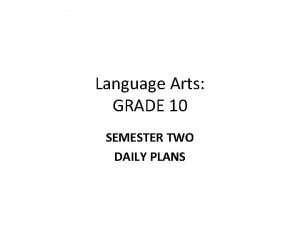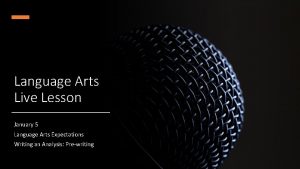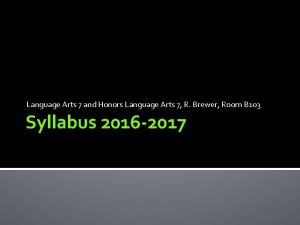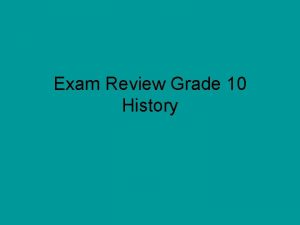th 6 grade Language Arts Semester Exam Review
















- Slides: 16

th 6 grade Language Arts Semester Exam Review

Conflict • Definition: struggle • 2 types of conflict: • A. Internal (a character’s struggle within his/her own heart and mind- with an emotion, feeling, choice, decision) • B. External (a character’s struggle with an outside force- another person, society, or nature)

Elements of FICTION: the things that are present in fictional stories • 1. Characters: people in the story • 2. Setting: the time & place the story happens • 3. Plot: the events that make up a story: exposition, rising action, climax, falling action, resolution • 4. Theme: the general message about life in the story • 5. Point of View: who is telling the story?

Parts of a Plot • Exposition: the introduction of the characters, setting, and basic situation • Rising action: events that lead to the climax • Climax: point of greatest excitement or tension • Falling action: events that follow the climax • Resolution: the final outcome of the story (how things end up)

Point of View: determines the narrator & how much the reader knows v v 1 st person point of view: Narrator is a character IN the story. Uses the word “I” to refer to himself or herself Narrator cannot tell us what other characters think or feel. Narrator only knows what he/she directly sees , hears, or is told. Example: I was minding my own business when Mom burst in. “What’s with you? ” I grumbled. Example: an eyewitness account of a crime (“I saw……. . ”)

3 rd person point of view: vhe said / she said v. Uses words such as “he”, “she”, “they” v. The narrator is NOT a character in the story. v 3 rd person is an outsider’s point of view.

Theme • The general message about life in a story • Can be stated in a single sentence • Think of bumper sticker type slogans or sayings Try to identify a theme for the stories we have read!

Figurative Language • Simile (not SMILE): a comparison between two unlike things using the words “like” or “as” (example: He eats LIKE a pig. ) • Metaphor: a direct comparison between two unlike things (example: Her skin is pure silk).

Fiction & Nonfiction • Fiction: a work of fiction contains one or more made up elements (example: a novel or short story) • Nonfiction: a work of fiction based entirely on facts and true information that can be verified (example: a textbook, newspaper article, encyclopedia entry, biography)

Capitalization • Capitalize the word “I” • Capitalize the first word of every sentence • Capitalize all proper nouns (example: Cindy, New York, Atlanta Museum of Art, Redstone Avenue, Shoal River Middle School)

Apostrophe • Use apostrophes in contractions (the apostrophe takes the place of the letter or letters you remove to combine two words). Example: can not= can’t; have not = haven’t • Use apostrophes to show possession or ownership. (Example: That is my dog’s bowl. Tom’s book is lost).

Common Errors • Its and It’s: only use it’s if you are trying to say IT IS (example: Which is correct? My dog wags its/it’s tail. ) • Your and You’re: only use you’re if you are trying to say YOU ARE (example: Which is correct? I am going to your/you’re house today. Sally said your/you’re going to be home after 3: 00.

Determining meaning of unknown words • When you encounter an unfamiliar word, it is most helpful to use CONTEXT CLUES • Context clues are hints as to the meaning of a word • Context clues might be found in the same sentence, or in a nearby sentence (reread sentence before and after the word to find clues) • Example: • The woman gingerly carried the delicate china across the room. She wanted to be very careful not to break it.

Punctuating Titles • Title of a short work: use quotation marks • Title of a long work: underline • **never use BOTH underlining AND quotation marks (one OR the other) • **Capitalize the first word & all important words in a title (do not capitalize a, an, or the unless they are the 1 st word of title)

Synonyms & Antonyms • Synonym: a word that means the same, or nearly the same, as another word (example: hurriedly & quickly) • Antonym: a word that means the opposite of another word (example: quickly & slowly)

Main Idea • Ask yourself: what is the POINT? • Main Idea of a nonfiction passage is similar to theme in a fictional story: what is the big idea or main point? • Hint: often the TITLE of a nonfiction passage can give a hint as to the main idea • Ask yourself: what is the passage MOSTLY about? What is the BIG IDEA or POINT of the whole passage? • Don’t confuse a DETAIL with the MAIN IDEA- details are just support for the main idea (examples, etc…. )
 Creative arts grade 8 term 2 notes
Creative arts grade 8 term 2 notes World history semester 1 exam
World history semester 1 exam U.s. history semester 2 final exam
U.s. history semester 2 final exam Zoology final exam review
Zoology final exam review Physics fall semester review answers
Physics fall semester review answers Us history final exam study guide
Us history final exam study guide English 3 fall semester exam review
English 3 fall semester exam review Verbal irony def
Verbal irony def Chemistry
Chemistry World history semester 1 final exam study guide answers
World history semester 1 final exam study guide answers Chemistry 1 semester exam review
Chemistry 1 semester exam review Grade 10 biology unit 1
Grade 10 biology unit 1 Ap gov final review
Ap gov final review English 3 semester exam
English 3 semester exam Biology second semester final exam answers
Biology second semester final exam answers Earth science final exam answers
Earth science final exam answers Algebra 1 semester 2 final review
Algebra 1 semester 2 final review




